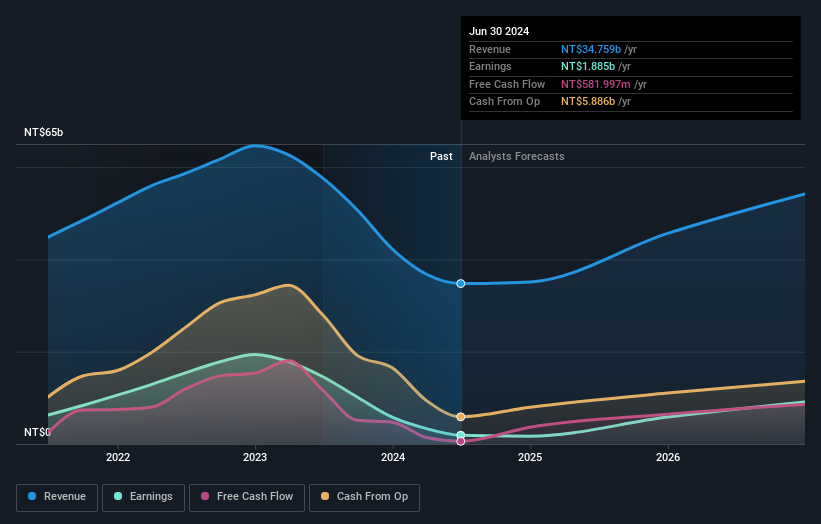- Taiwan
- /
- Electronic Equipment and Components
- /
- TWSE:8046
Nan Ya Printed Circuit Board Corporation's (TWSE:8046) top owners are public companies with 67% stake, while 27% is held by individual investors

Key Insights
- Nan Ya Printed Circuit Board's significant public companies ownership suggests that the key decisions are influenced by shareholders from the larger public
- The largest shareholder of the company is Nan Ya Plastics Corporation with a 67% stake
- Ownership research along with analyst forecasts data help provide a good understanding of opportunities in a stock
Every investor in Nan Ya Printed Circuit Board Corporation (TWSE:8046) should be aware of the most powerful shareholder groups. The group holding the most number of shares in the company, around 67% to be precise, is public companies. In other words, the group stands to gain the most (or lose the most) from their investment into the company.
Individual investors, on the other hand, account for 27% of the company's stockholders.
Let's take a closer look to see what the different types of shareholders can tell us about Nan Ya Printed Circuit Board.
See our latest analysis for Nan Ya Printed Circuit Board

What Does The Institutional Ownership Tell Us About Nan Ya Printed Circuit Board?
Many institutions measure their performance against an index that approximates the local market. So they usually pay more attention to companies that are included in major indices.
Nan Ya Printed Circuit Board already has institutions on the share registry. Indeed, they own a respectable stake in the company. This implies the analysts working for those institutions have looked at the stock and they like it. But just like anyone else, they could be wrong. When multiple institutions own a stock, there's always a risk that they are in a 'crowded trade'. When such a trade goes wrong, multiple parties may compete to sell stock fast. This risk is higher in a company without a history of growth. You can see Nan Ya Printed Circuit Board's historic earnings and revenue below, but keep in mind there's always more to the story.

We note that hedge funds don't have a meaningful investment in Nan Ya Printed Circuit Board. Nan Ya Plastics Corporation is currently the largest shareholder, with 67% of shares outstanding. With such a huge stake in the ownership, we infer that they have significant control of the future of the company. AllianceBernstein L.P. is the second largest shareholder owning 1.0% of common stock, and Japan Securities Finance Co. Ltd., Asset Management Arm holds about 0.6% of the company stock.
While studying institutional ownership for a company can add value to your research, it is also a good practice to research analyst recommendations to get a deeper understand of a stock's expected performance. Quite a few analysts cover the stock, so you could look into forecast growth quite easily.
Insider Ownership Of Nan Ya Printed Circuit Board
While the precise definition of an insider can be subjective, almost everyone considers board members to be insiders. The company management answer to the board and the latter should represent the interests of shareholders. Notably, sometimes top-level managers are on the board themselves.
Insider ownership is positive when it signals leadership are thinking like the true owners of the company. However, high insider ownership can also give immense power to a small group within the company. This can be negative in some circumstances.
Our most recent data indicates that insiders own less than 1% of Nan Ya Printed Circuit Board Corporation. It's a big company, so even a small proportional interest can create alignment between the board and shareholders. In this case insiders own NT$34m worth of shares. It is good to see board members owning shares, but it might be worth checking if those insiders have been buying.
General Public Ownership
The general public-- including retail investors -- own 27% stake in the company, and hence can't easily be ignored. While this size of ownership may not be enough to sway a policy decision in their favour, they can still make a collective impact on company policies.
Public Company Ownership
Public companies currently own 67% of Nan Ya Printed Circuit Board stock. We can't be certain but it is quite possible this is a strategic stake. The businesses may be similar, or work together.
Next Steps:
While it is well worth considering the different groups that own a company, there are other factors that are even more important. Take risks for example - Nan Ya Printed Circuit Board has 2 warning signs (and 1 which shouldn't be ignored) we think you should know about.
If you would prefer discover what analysts are predicting in terms of future growth, do not miss this free report on analyst forecasts.
NB: Figures in this article are calculated using data from the last twelve months, which refer to the 12-month period ending on the last date of the month the financial statement is dated. This may not be consistent with full year annual report figures.
Valuation is complex, but we're here to simplify it.
Discover if Nan Ya Printed Circuit Board might be undervalued or overvalued with our detailed analysis, featuring fair value estimates, potential risks, dividends, insider trades, and its financial condition.
Access Free AnalysisHave feedback on this article? Concerned about the content? Get in touch with us directly. Alternatively, email editorial-team (at) simplywallst.com.
This article by Simply Wall St is general in nature. We provide commentary based on historical data and analyst forecasts only using an unbiased methodology and our articles are not intended to be financial advice. It does not constitute a recommendation to buy or sell any stock, and does not take account of your objectives, or your financial situation. We aim to bring you long-term focused analysis driven by fundamental data. Note that our analysis may not factor in the latest price-sensitive company announcements or qualitative material. Simply Wall St has no position in any stocks mentioned.
About TWSE:8046
Nan Ya Printed Circuit Board
Manufactures and sells printed circuit boards (PCBs) in Taiwan, the United States, Mainland China, Korea, and internationally.
Flawless balance sheet with reasonable growth potential.
Similar Companies
Market Insights
Community Narratives




